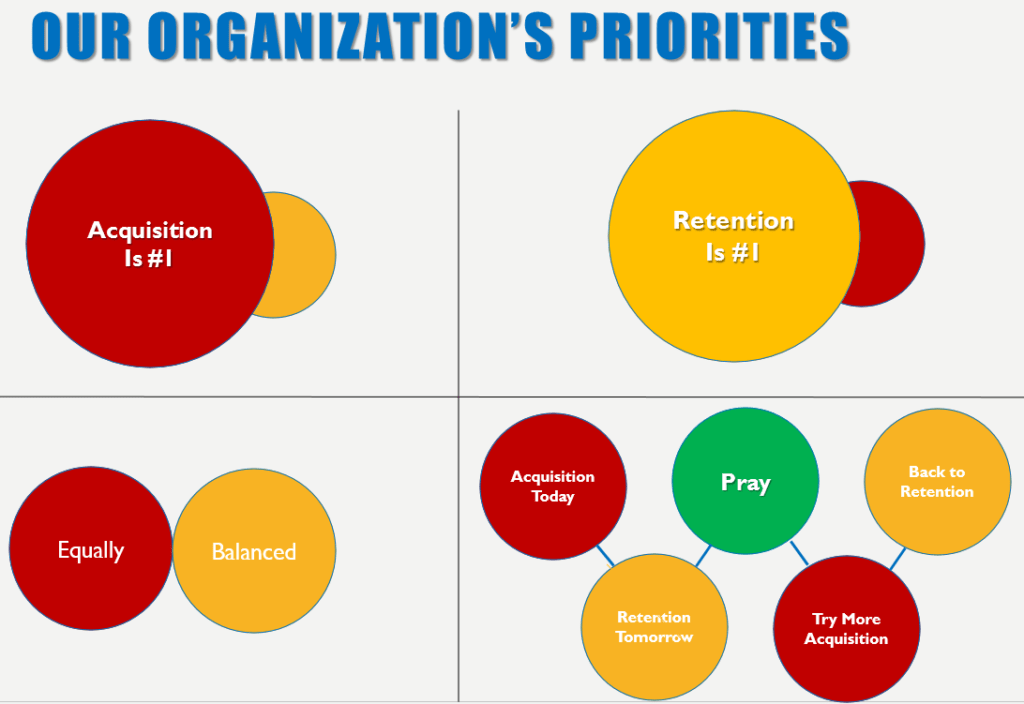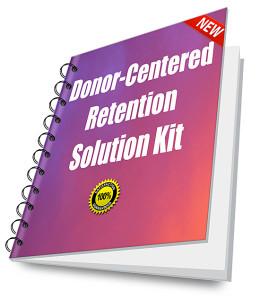
Where does retention fall within your priorities?
EIght years ago,Tom Belford of The Agitator penned a post entitled “Donor Retention … Why Is It So Hard?”
At the time I thought: Great question!
Alas, things haven’t improved. It’s still hard.
Why, oh why, oh why?!?!
I’d like to explore this a bit, and I hope you’ll join me.
First, are you finding it difficult?
If so, why do you think that’s the case?
If not, and you’re being successful getting repeat gifts, I’d love to hear why you think things are working well for you.
If you’re reading this article you probably already know how important donor retention is.
- You’ve probably read Dr. Adrian Sargeant’s research pointing to the fact that just a 10% increase in retention annually can increase the lifetime value of your current donor base by 200%.
- You may have read the excellent material made available by Zach Shefska on The Data-Driven Fundraiser’s Reference Guide, with similar data showing the impact of every 1% increase in retention on donor lifetime value.
- You may be familiar with the Rogare’s Relationship Fundraising Review about the need to make a conscious, concerted effort to make donors feel good if you want to keep them.
- Perhaps you’re aware of these excellent books designed to help nonprofits improve the lifetime value of their donors, including Roger Craver’s Retention Fundraising: The New Art and Science of Keeping Your Donors for Life and Jay Love’s Stay Together: How to Encourage a Lifetime of Donor Loyalty.
- I offer my own Donor Retention and Gratitude Playbook where you’ll find dozens of actionable tips to help you retain and upgrade more donors.
There’s never been so much readily available general information about donor retention.
The resources suggested above are terrific, and there are many others. Truly, in the four decades I’ve worked in facilitating philanthropy, there’s never been this much data and research accessible. So, with all this great information available, what gives?
Why do the Fundraising Effectiveness Project Reports show a steady decline in donor retention over more than a decade?
- We know donor retention is abysmal.
- We also absolutely know from this research that if you can renew a first-time donor just once, you’ll increase their chances of giving again from 23% to 60%.
Let me put that another way.
If you prioritize getting a second gift, your donor is three times more likely to stay with you than if you don’t have a targeted second gift strategy.
This is HUGE. How could it be the more we know, the worse we do?
Tom Belford of the Agitator asks: Why aren’t we getting the job done?
I’ve thought about this, and I’m going to let you know what I think. Do with it what you will.
I think it’s not getting done because it’s not getting prioritized.
If you know something, but do nothing about it, nothing changes.
Again, if you’re reading this I’m probably preaching to the choir. You know what needs to be done to move the needle on donor retention. You may even be doing it at your organization. At least somewhat. But, how committed are you to improving donor retention?
- Do you measure it?
- Do you regularly evaluate it?
- Do you develop strategies to improve the weak areas?
- Do you have a written donor retention plan?
WIthout a system, one you follow religiously, the information about how to improve donor retention isn’t likely to ripple very far.
It’s as if you’ve dropped a pebble into a tar pit rather than a pond.
The information, like the pebble, gets stuck before it moves very far.
Every time I give a presentation about improving donor retention, I’m astonished:
- Many people don’t know their retention rates.
- Many wouldn’t even know how to calculate them!
- Others, who do know their rates (generally abysmal), do little to pass along this knowledge to the rest of their team.
- Leadership (e.g., executive directors and boards) think very little about retention, if at all.
Executive staff and boards need seasoned development professionals to lead the way.
Change happens when people understand it must.
Sadly, this too often means hitting rock bottom before anything is done.
Organizations continue to leak donors until they reach a crisis. At that point:
- They decide to bring in a development director (or even a new executive director) to “save the day.”
- The new folks coming in inherit a bunch of fires that must be put out.
- Retention gets stuck (once again) on the back burner — because no one knows the ropes, and donor retention is a long-term game.
Development staff need mentors to show them the way forward, and help them to focus on both short- and long-term outcomes. [I know I’m a coach, so this may sound self-serving, but I don’t care who you hire to help you. Truth is: coaches have time to read all the literature, stay updated on best practices and get folks up to speed. They have experience and can share analytic tools for measuring retention and focusing strategies according to results.
Donor retention is a prevention strategy.
People in the trenches often get embroiled in putting out fires — neglecting to invest in prevention.
Want to avoid the fires getting started in the first place? You need a retention strategy to safeguard all your hard work.
- You put your money in a bank and hire investment advisers to assure it yields a positive return.
- Why wouldn’t you similarly safeguard your hard-won donors by hiring advisers (staff and/or coaches) to assure they also yield a long-term positive return?
If you were losing 80% (first-time donor retention rate) or even 46% (repeat donor retention rate) of your bank account every year, alarms would be sounding at high decibels! [See the Fundraising Effectiveness Project reports.]
If your donor retention is average or below average (you can benchmark your results here), it’s time to sound the alarms. Ask these most important questions:
- What can we do to prevent this?
- Why aren’t we doing this now?
- And, if not now, when?
How to get organizational priorities straight.
If you can’t do everything right now, prioritize where the yield may be highest.
- If you’re a new nonprofit (less than five years old), it makes sense to prioritize donor acquisition. This should be obvious; if you have no donors, you’ve nothing to retain. Of course, retention shouldn’t be ignored.
- If you’ve been in existence five years or more, you should be putting acquisition and retention on at least an equal footing. You’re still building your base, but you also need to solidify it. You can’t afford to see it erode.
- If you’re well established, you would do well to consider prioritizing retention — especially looking at new donors who give between $100 and $250. In my humble opinion, these folks are ‘gold.’ They’ve demonstrated an affinity for what you do, as well as a notable philanthropic bent (after all, a $100+ gift is different than a $10 gift). This makes these donors a much better target market than relative strangers who’ve never given to you.
- For ongoing donors, Fundraising Effectiveness Project reports show:
-
- Mid-level donors tend to be neglected, causing them to renew at generally poor rates. But, If you can renew and upgrade them to higher levels of support, your odds of them continuing to stick with you increase significantly. There is a direct relationship between gift value and loyalty.
- $250+ donors have higher renewal rates than donors giving between $100 to $249, and both groups renew at a higher rate than under $100 donors.
When determining how to allocate limited resources, keep in mind retention is a more cost-effective strategy than acquisition. Much more.
Make return on investment and life-time donor value your complementary mantras.
It costs money to make money.
Donor acquisition is expensive. In fact, it can cost two to three times as much as a donor will give you with their first gift. In the short-term, especially when you’re getting your nonprofit up and running, you must invest capital that won’t yield an immediate return. It can take 12-18 months before a given donor relationship becomes profitable. So this is clearly a long-term proposition.
Acquiring a new donor for just a one-time transaction makes NO sense at all!
Do you know how much it cost you last year to acquire each new donor via a direct mail appeal or e-appeal? [Download the Ultimate Fundraising Donor Acquisition Cost Cheat Sheet if you want to figure it out.]. You’re likely not to break even your first year. The donors you acquire will only be worth it to you if you renew them over time — which is where the concept of ‘life-time donor value’ comes in.
Donor lifetime value is a prediction of how much you can expect to receive from a donor over the lifetime of their affiliation with your nonprofit [read a comprehensive article by Zach Shefska of the Fundraising Report Card on Measuring Fundraising ROI with Donor Lifetime Value].
What you do impacts donor lifetime value, either positively or negatively.
Summary: Why aren’t you retaining more donors?
If you passively wait for donors (especially first-timers) to renew, without significant, active stewardship on your part, retention rates will be sub-par.
Take a look at your priorities.
- How many resources (budget, staff and volunteers) are you investing in donor retention?
- Do you have an infrastructure (database and CRM) that facilitates evidence-based fundraising and donor retention?
- Do you have a written donor retention plan?
- Does your plan have goals, measurable objectives, specific strategies, timelines and assigned responsibilities.
- Or are you “doing retention” on a wing and a prayer — an acquire today, retain tomorrow, try to fit stuff in whenever you can — and pray that it all will work out in the end?
The data shows, for the average nonprofit, it’s not working out so well.
So, ask yourself: “How can we take the donor retention bull by the horns?”
Make this the year you get your retention priorities straight!
Please share your thoughts in the COMMENTS below as to why nonprofit donor retention rates have been steadily decreasing, despite the fact the data shows us the enormity of the problem?
Want an Easy-to-Develop Strategic Retention Plan?
 Grab my 6-volume Donor Retention and Gratitude Playbook. It’s your comprehensive road map to an intentional donor retention system! Not yet a paid Clairification School subscriber? Enroll here to save almost 50% on this resource, and receive generous discounts on all Clairification products. Plus you’ll get exclusive monthly tips, and access to an archive of 1,000+ articles — and all new articles too, of course!
Grab my 6-volume Donor Retention and Gratitude Playbook. It’s your comprehensive road map to an intentional donor retention system! Not yet a paid Clairification School subscriber? Enroll here to save almost 50% on this resource, and receive generous discounts on all Clairification products. Plus you’ll get exclusive monthly tips, and access to an archive of 1,000+ articles — and all new articles too, of course!





